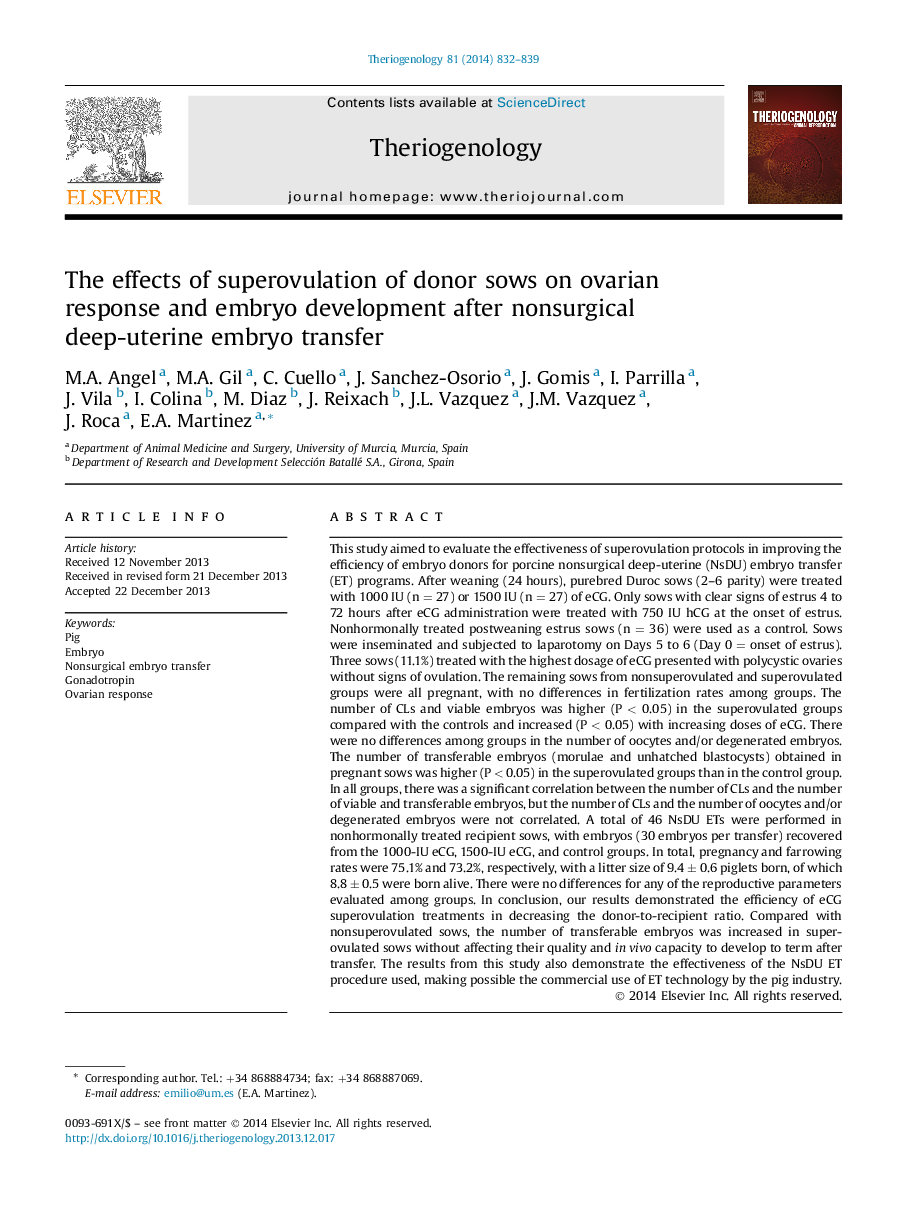| کد مقاله | کد نشریه | سال انتشار | مقاله انگلیسی | نسخه تمام متن |
|---|---|---|---|---|
| 10893736 | 1082230 | 2014 | 8 صفحه PDF | دانلود رایگان |
عنوان انگلیسی مقاله ISI
The effects of superovulation of donor sows on ovarian response and embryo development after nonsurgical deep-uterine embryo transfer
ترجمه فارسی عنوان
اثرات سوپرآلولاسیون گاوهای کمک کننده بر پاسخ تخمدان و رشد جنین پس از انتقال جنین عمیق رحمی غیر جراحی
دانلود مقاله + سفارش ترجمه
دانلود مقاله ISI انگلیسی
رایگان برای ایرانیان
کلمات کلیدی
خوک، جنین، انتقال جنین غیرقانونی، گنادوتروپین، پاسخ تخمدان،
موضوعات مرتبط
علوم زیستی و بیوفناوری
علوم کشاورزی و بیولوژیک
علوم دامی و جانورشناسی
چکیده انگلیسی
This study aimed to evaluate the effectiveness of superovulation protocols in improving the efficiency of embryo donors for porcine nonsurgical deep-uterine (NsDU) embryo transfer (ET) programs. After weaning (24 hours), purebred Duroc sows (2-6 parity) were treated with 1000 IU (n = 27) or 1500 IU (n = 27) of eCG. Only sows with clear signs of estrus 4 to 72 hours after eCG administration were treated with 750 IU hCG at the onset of estrus. Nonhormonally treated postweaning estrus sows (n = 36) were used as a control. Sows were inseminated and subjected to laparotomy on Days 5 to 6 (Day 0 = onset of estrus). Three sows (11.1%) treated with the highest dosage of eCG presented with polycystic ovaries without signs of ovulation. The remaining sows from nonsuperovulated and superovulated groups were all pregnant, with no differences in fertilization rates among groups. The number of CLs and viable embryos was higher (P < 0.05) in the superovulated groups compared with the controls and increased (P < 0.05) with increasing doses of eCG. There were no differences among groups in the number of oocytes and/or degenerated embryos. The number of transferable embryos (morulae and unhatched blastocysts) obtained in pregnant sows was higher (P < 0.05) in the superovulated groups than in the control group. In all groups, there was a significant correlation between the number of CLs and the number of viable and transferable embryos, but the number of CLs and the number of oocytes and/or degenerated embryos were not correlated. A total of 46 NsDU ETs were performed in nonhormonally treated recipient sows, with embryos (30 embryos per transfer) recovered from the 1000-IU eCG, 1500-IU eCG, and control groups. In total, pregnancy and farrowing rates were 75.1% and 73.2%, respectively, with a litter size of 9.4 ± 0.6 piglets born, of which 8.8 ± 0.5 were born alive. There were no differences for any of the reproductive parameters evaluated among groups. In conclusion, our results demonstrated the efficiency of eCG superovulation treatments in decreasing the donor-to-recipient ratio. Compared with nonsuperovulated sows, the number of transferable embryos was increased in superovulated sows without affecting their quality and in vivo capacity to develop to term after transfer. The results from this study also demonstrate the effectiveness of the NsDU ET procedure used, making possible the commercial use of ET technology by the pig industry.
ناشر
Database: Elsevier - ScienceDirect (ساینس دایرکت)
Journal: Theriogenology - Volume 81, Issue 6, 1 April 2014, Pages 832-839
Journal: Theriogenology - Volume 81, Issue 6, 1 April 2014, Pages 832-839
نویسندگان
M.A. Angel, M.A. Gil, C. Cuello, J. Sanchez-Osorio, J. Gomis, I. Parrilla, J. Vila, I. Colina, M. Diaz, J. Reixach, J.L. Vazquez, J.M. Vazquez, J. Roca, E.A. Martinez,
